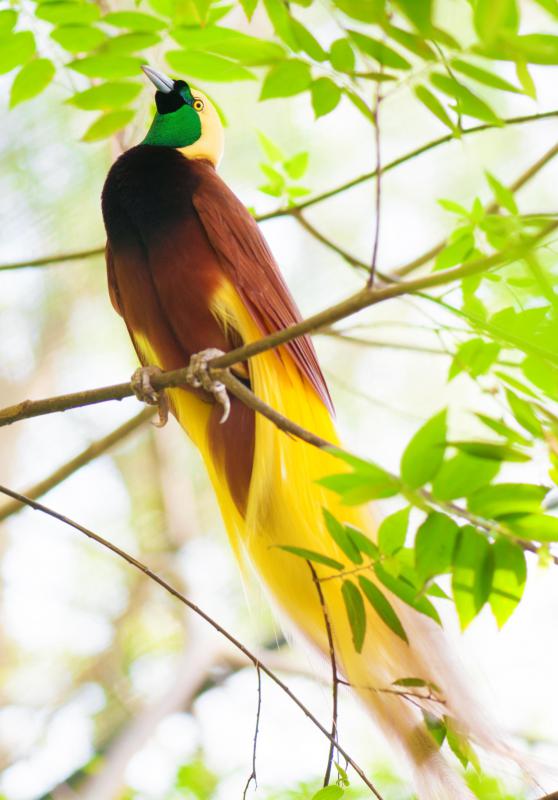At AllThingsNature, we're committed to delivering accurate, trustworthy information. Our expert-authored content is rigorously fact-checked and sourced from credible authorities. Discover how we uphold the highest standards in providing you with reliable knowledge.
What are Birds-Of-Paradise?
Birds-of-paradise are members of the Paradisaeidae family and are known for their attractive and distinctive plumage. Typically, birds-of-paradise live in rainforest regions, and most are found on the island of New Guinea. Another of the bird’s distinguishing features is their complex mating habits — males of many species perform intricate mating dances. Birds-of-paradise are close relatives of the crow family. Some examples of species include the Paradise crow and Western Parotia.
There are 40 different species of birds-of-paradise, with the vast majority native to New Guinea. There are also several species in Australia and Indonesia. Some species are widespread in the rainforests of New Guinea, but others are confined to relatively small regions depending on the exact habitat that they require.

The elaborate and bright coloring of the male plumage is for mating purposes. Males of many species use a number of techniques to display their colors, including posing and dancing. In some cases, these rituals can last for several hours. The males of most species are polygamous, which means they have more than one partner in a lifetime, but there is at least one species that is monogamous.

It is thought that all birds-of-paradise species nest in pairs rather than in large groups. Some species build nests on the ground, while others build in foliage. When a chick is born, it has no feathers and is almost completely helpless until it has gained strength. During this time, both parents will bring the chick food.
Birds-of-paradise have bodies which are very similar to crows. The largest is about 17 inches (44 cm) in height, while the smallest is only 6 inches (15cm). Plumage varies greatly between different species, as does the shape and size of the bill.

Typically, birds-of-paradise live mainly off fruit, although some species also eat small creatures. The diet of a particular bird depends on the exact species. For example, the Crested bird-of-paradise primarily eats insects, whereas other species get the majority of their nutrition from plants.
Due to the their attractive plumage, they have been regular targets for hunters who wish to sell their feathers. Despite this, there are no species that are currently thought to be endangered. It is possible, however, that this will change in the near future as more of the birds' habitat is destroyed. There are some species which are kept in aviaries, but the difficulty in breeding the birds has stopped them from becoming popular amongst amateurs.
Frequently Asked Questions
What are Birds-of-Paradise?

Birds-of-Paradise are a group of bird species known for their remarkable plumage and extraordinary mating displays. They belong to the family Paradisaeidae and are native to New Guinea, eastern Australia, and nearby islands. These birds exhibit a stunning diversity of feather colors and structures, with males often sporting elaborate tail feathers, crests, and breast shields to attract mates.
How many species of Birds-of-Paradise are there?
There are approximately 42 species of Birds-of-Paradise, according to the Cornell Lab of Ornithology. Each species has its unique set of behaviors and appearances, ranging from the iconic ribbon-like tail feathers of the Wilson's Bird-of-Paradise to the iridescent throat pouch of the Magnificent Riflebird.
Why do Birds-of-Paradise have such vibrant colors and elaborate dances?
Birds-of-Paradise have evolved their vibrant colors and elaborate dances primarily through sexual selection. Females preferentially choose males with the most impressive displays, leading to a competitive drive among males to develop more extravagant features and dances to increase their chances of mating success. This evolutionary process has resulted in the incredible diversity of displays seen today.
Where can Birds-of-Paradise be found in the wild?
Birds-of-Paradise are predominantly found in the dense rainforests of New Guinea, with some species inhabiting parts of eastern Australia, the Moluccas, and the eastern Indonesian islands. They are most diverse in New Guinea, where the majority of the species are concentrated.
Are Birds-of-Paradise endangered?
The conservation status of Birds-of-Paradise varies by species. While some are relatively common, others face threats from habitat loss and hunting. For instance, the IUCN Red List classifies several species as Near Threatened or Vulnerable, highlighting the need for conservation efforts to protect these unique birds and their habitats.
What role do Birds-of-Paradise play in their ecosystems?
Birds-of-Paradise are important members of their ecosystems, acting as pollinators and seed dispersers. Their feeding habits help to maintain the health of the forest by spreading pollen and seeds, which contributes to plant diversity and forest regeneration. Additionally, their elaborate displays contribute to the rich biodiversity that characterizes their habitats.
AS FEATURED ON:
AS FEATURED ON:














Discussion Comments
Post your comments